Still a tight labor market for many industries, but the massive churn slows.
By Wolf Richter for WOLF STREET.
Funny how the breathless headlines about global layoffs in 2022 and early 2023 by tech and social media companies have faded since spring. And then job openings in the “Information” sector, where some of them are grouped, started spiking again.
“Information” is a small sector (3 million employees) engaged in web search portals, data processing, data transmission, information services, software publishing, motion picture and sound recording, broadcasting including over the Internet, and telecommunications. The data jumps up and down from month to month, so we look at the three-month moving average to see the trends.
The reason I show Information up front is because it’s funny how the layoff binge-announcements – one of the factors last year that put us at WOLF STREET on intense recession watch – have turned into a job-openings binge. Note, the data is not based on online job postings, but on surveys of 21,000 company sites, released today by the Bureau of Labor Statistics.
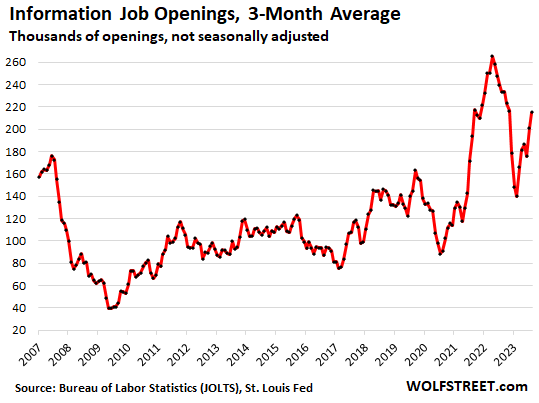
Overall Job openings jumped in August to 9.61 million, back where it had been in May, thereby filled in the drops in June and July, and so kept the three-month moving average for August roughly unchanged at 9.23 million, according to today’s data from the Job Openings and Labor Turnover Survey (JOLTS) of 21,000 work sites.
In 2021 and early 2022, part of the surge in job openings was driven by a spike in voluntary quits, where workers quit one job to jump to a better job amid large-scale labor shortages. When these workers jumped ship, they left job openings behind. Now quits have subsided from this spike, as we’ll see in a moment, so there is less churn in the labor force; and by not quitting, workers aren’t leaving behind job openings, which caused part of the surge of job openings to unwind.
Those 9.23 million job openings (three-month moving average) are still 29% above the same period in 2019, indicating that some industries are still having trouble staffing up to meet demand. This includes “Information” depicted above and some other big industries we’ll look at in a moment.
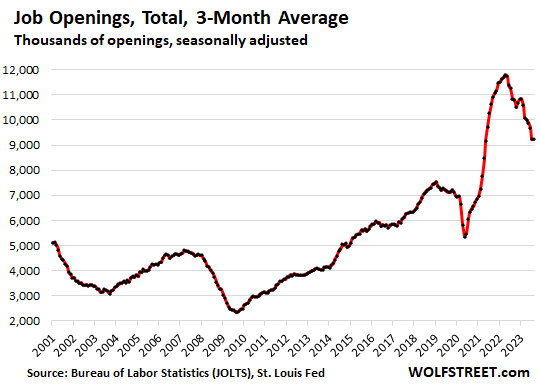
Layoffs and discharges were roughly unchanged in August dipped to 1.68 million. The three-month moving average irons out some of the monthly ups and downs. At 1.64 million for August, it remains below the lows before the pandemic, and 9.1% below the same period in 2019.
In the years before the pandemic, layoffs and discharges averaged 1.8 million per month, which was part of the normal course of business. During the Great Recession, monthly layoffs and discharges topped out at 2.6 million. In March 2020, they blew through 13 million.
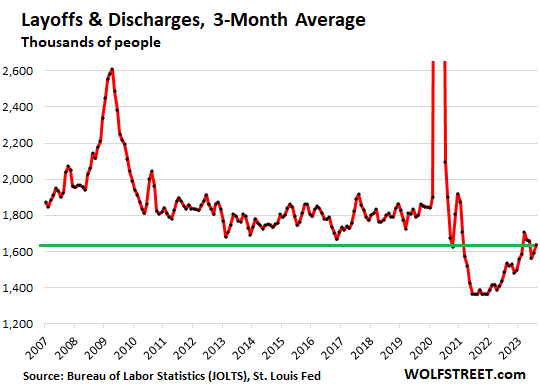
Quitting is less appealing. Voluntary quits in August ticked up to 3.64 million. But the three-month moving average shows the trend, and the trend is down.
It seems, all this layoff-talk and the actual layoffs that took place last year and earlier this year have reduced the enthusiasm by workers to look for the greener grass on the other side of the fence.
It seems people are more willing to hang on to the jobs they’ve got, or employers have responded with higher pay and better working conditions to hang on to their workers, or a combination of factors.
The drop in voluntary quits is a sign that the immense churn in the labor force is subsiding, which is a big relief for employers.
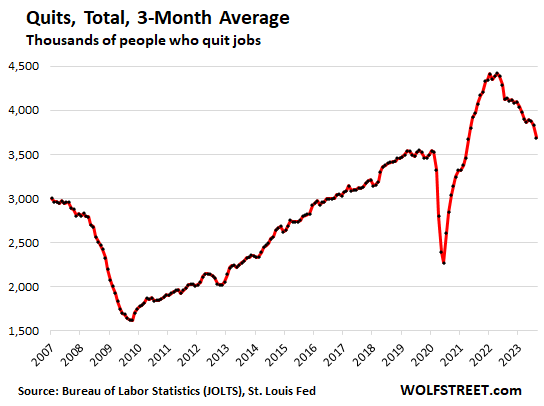
Hires — fewer quits, therefore fewer open jobs to fill — have been on a downtrend as well. In August, new hires rose to 5.86 million. But the three-month moving average dipped to 5.87 million, the lowest since March 2021 and right back where it had been in the Good Times before the pandemic.
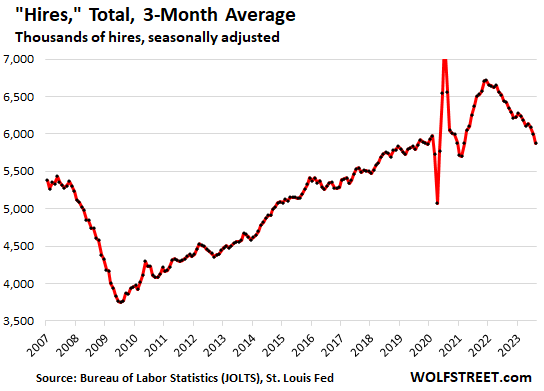
Job openings by largest private-sector industry categories.
Not all industries face the same labor issues. So here are the job openings of the largest industry categories.
Professional and business services (22.4 million employees), include some of the tech and social media companies (others are in “information” or in other categories): Professional, Scientific, and Technical Services; Management of Companies and Enterprises; Administrative and Support, and Waste Management and Remediation Services.
Job openings in August jumped by 509,000, pushing up the three-month moving average to 1.64 million, after a year-and-half of mostly declines. The three-month moving average is still 28% above the same period in 2019:
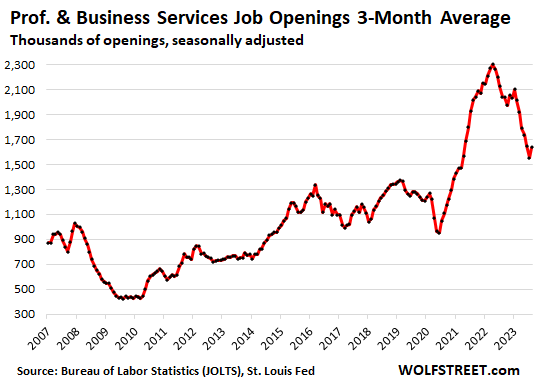
Healthcare and social assistance (21 million employees): the three-month moving average of job openings has hovered all year in the same high range of 1.72 million to 1.88 million. In August, the three-month moving average ticked up to 1.74 million, 46% higher than in the same period in 2019:
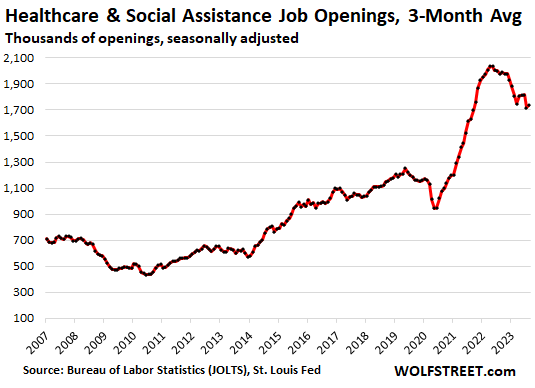
Leisure and hospitality (16 million employees): The three-month moving average of job openings has been on a consistent downtrend. In August, it ticked down to 1.19 million. But it’s still 25% higher than in the same period in 2019:
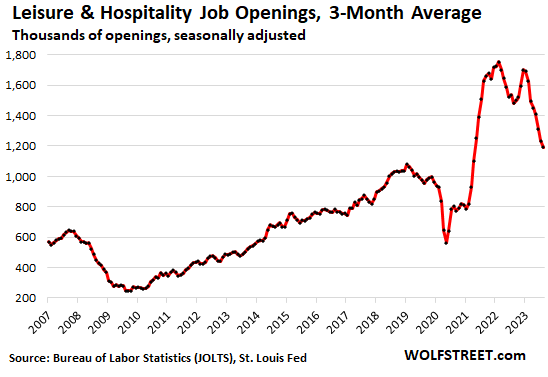
Retail trade, (16 million employees): The sector normalized in mid-2022 and has trended lower since then. This sector includes brick-and-mortar retailers as well as the retail-related employees of ecommerce operations, but not their tech workers, warehouse workers, drivers, etc.
Mall stores have been at the core of the brick-and-mortar meltdown, as I have called it since 2016, as Americans have shifted much of their mall-shopping to ecommerce. Countless stores have been shuttered, once lively malls have turned into zombie malls to be bulldozed and redeveloped into housing or whatever else. But employment at some segments of brick-and-mortar retail is doing well, such as grocery stores, auto dealers, gas stations, and cannabis shops. At many others, employment has been gutted.
Ecommerce is booming, but ecommerce is structurally shifting employment from retail locations to warehousing and transportation.
In August, the three-month moving average of job openings fell to 705,000, down by 14% from the same period in 2019:
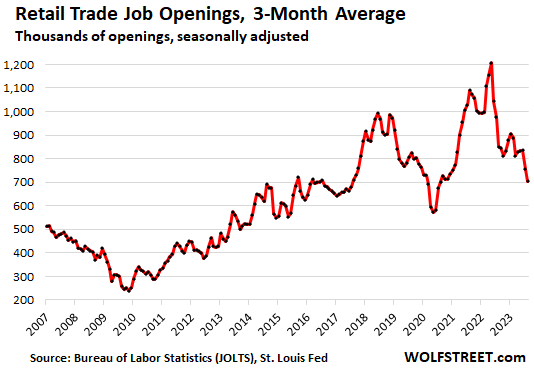
Manufacturing (13 million employees). Job openings in August jumped by 72,000, which pushed up the three-month moving average a tad to 580,000, the first increase since May 2022. Job openings are up 28% from the same period in 2019:
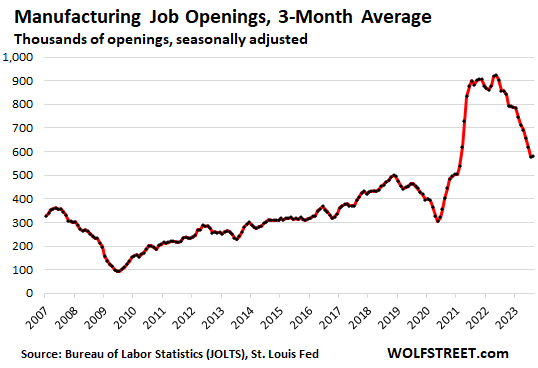
Construction, all types (8 million employees): Job openings had dropped sharply in early 2023 on the horrendous rains and flooding on the West Coast over the three-month period. When the waters receded, job openings bounced off.
In August, the three-month moving average ticked down to 363,000 job openings, up by 18% from the same period in 2019:
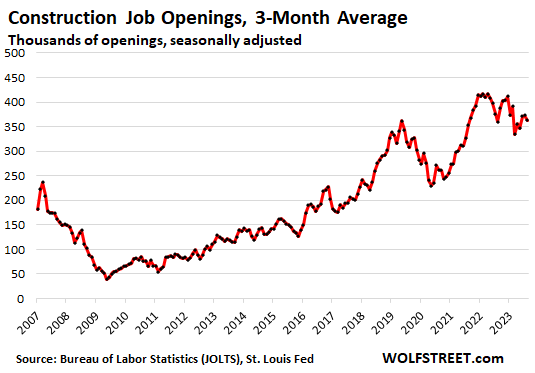
Enjoy reading WOLF STREET and want to support it? You can donate. I appreciate it immensely. Click on the mug to find out how:
![]()


Very interesting analysis. It seems to me that IT job openings are almost perfectly correlated and fast synchronized with FED’s money printing binge. The other sectors seem to move more slowly and more stable.
There is no ‘money printing binge’ whatsoever by the Federal Reserve which is continuing shrinking its balance sheet substantially.
I meant the money printing binges that FED implemented in the past. Not at this moment.
There is one thing about this shrinking though. They’re not shrinking holding of ten year bonds and higher. In fact, they’re showing a slight QE.
All of the reduction in the Fed’s balance sheet is shorter term holdings. So, they’re still monkeying around with yield curve control. But, I think the cat is out of the bag, because I was hearing this on CNBC.
Total BS. Who is spreading this stuff?
What matures, rolls off. If a 10-year bond matures, it rolls off. If less than $60 billion in notes (2-10 year) and bonds (20-30 year) mature in a month, then T-bills make up the difference. In the few months now that over $60 billion in notes and bonds mature, say $65 billion mature, the Fed lets $60 billion roll off and replaces the $5 billion. In any of these cases, $60 billion a month roll off.
During QE, the Fed bought the notes and bonds in the market via its primary dealers. So in 2012, for example, it might buy 30-year bonds that had 12 years left to run, and they’ll come off in 2024. Etc. etc.
Anyone can look this up on the Fed’s maturity schedule, rather than spreading this ignorant BS here.
I believe the data is here, held by the Fed:
https://fred.stlouisfed.org/series/TREAS10Y
Your BS moniker may need an apology.
JeffD,
Seems you understand what you’re looking at and the dynamics underneath it. Switch the chart to year-over-year percent change, and you’ll see the trend, and you can guess the dynamics. QT started a little over a year ago. As I said, if you want know what is actually going on, look at the maturity schedule of what is rolling off going forward, and you will see. The key is the $60 billion a month cap. I explained all this in my comment to DownFed.
Calling this “QE” as DownFed had done is total bullshit.
PS It’s ok to learn from the comments sometimes.
Bigger picture in play.
China, Japan, Saudi Arabia all have been moving away from treasuries for forex reserves. This is an interesting sidebar since somewhere near 90% of payments globally are still made in dollars – confusing. The real victims appear to be Europe from a currency pov. Also suggests contraction is around the corner.
I went through the data from the Fed and he is correct, while there overall holdings are going down their holdings of bonds over 10years to maturity have gone up. One year ago it was 1454819 and today it is 1503507. Now I maybe reading their data wrong, but it would appear they have added to their total holdings of long term debt, though only slightly. It looks like they add to total every 3 months followed by a roll off a few days later that it is less then they added.
boikin
Every single security in this $1.5 trillion figure cited in the link (19% of the $8 trillion in total securities) is a 20-year or 30-year bond. There is not a single 10-year or 7-year or 2-year note in that $1.5 trillion.
When the roll-off goes over the $60 billion a month cap, the Fed replaces maturing 30-year bonds with new 30-year bonds, and it replaces maturing 2-year notes with new 2-year notes, etc., to the extent that the roll-off was over $60 billion.
So if the roll-off is $65 billion in one month, the Fed will replace $5 billion spread over the various maturities by buying new securities. There are now many months when the roll-off is below the cap, and no securities are replaced.
A 30-year bond that matures and rolls off next month matures in “1 month” and isn’t even in that $1.5 trillion that matures in “over 10 years.” None of the long-term bonds that mature before Oct 2033 (10 years from now) is in the figure of $1.5 trillion.
But when the Fed replaces $50 million in maturing 30-year bonds with $50 million in new 30-year bonds, the new 30-year bonds go on the over 10-year maturity list, while the maturing 30-year bonds that rolled off had NOT been on that list in 10 years because its maturity date was less than 10 years in the future.
This has the effect that the number of 30-year bonds on the Fed’s balance sheet DECLINES. But the new ones show up on that list, and the old ones that mature hadn’t been on the list in 10 years. That’s why this list crept higher.
Only morons who don’t understand how bonds work call this “QE.” This obliterating bullshit makes me scream.
Ok, Congress. Same results.
Yeah a lot of excess money flowed into tech because it offers huge future growth potential, and a lot of those companies used the money to expand or overhire to hoard talent as per what I’ve been reading here in the past. I mean everyone wants to invest in the next Amazon before it took over the world and become insanely wealthy insanely fast lol.
andy
Oct 1, 2023 at 10:10 am
7 out of 500 stocks are 28% of sp500. And trade at 30 P/E. Give or take. Dividend is 1.5%. And these are not even imaginary forward numbers. Long story short, it crashes.
Keep an eye on Meta (Facebook). Totally artificially being kept at $300. It crashes like there is no tomorrow. Same for Eli Lilly.
One of my Exs routinely pops up on linkedin and for several years her title was “Senior *redacted* at Meta” now its “Adjunct at *redacted* University”. /shrug
That’s quite a story. My Ex sent me *reducted* issue of Playboy magazine were she was centerfold (after we stopped dating). I still have it.
Wolf,
I would like to see a picture of Andy’s ex girl friend. Would you please allow him to post a pic?
/s
:-)
It’s a collector’s item, Harvey. I suppose I could send you an NFT ;-)
…has there been an ‘entropy edition’, lately?
may we all find a better day.
Keep your eye on Apple if China extends the ban from government locations to other parts of the country
MW: How Treasury market upheaval is rippling through global markets as the Bond Vigilantes ride into towns all across the world…
The long awaited recession and market melt-down refuses to come.
The “market meltdown” already started in late 2021. It’s a slow and halting meltdown for stocks, and it’s not caused by any kind of recession, but by the end of the Easy Money.
Someone once told me nothing goes to heck in a straight line.
Be carefull, job losses are often the last part of the cycle
It’s a cycle. There is no beginning and no end and no first part and no last part, and everything leads to everything else.
I don’t want to comment about unrelated topics, but I can’t skip this: I chuckled when I read this on CNBC today:
“Rates are expected to stay higher for longer, an idea Fed officials have tried to get the market to accept and which investors are only now beginning to absorb.
Getting used to a more typical rate structure doesn’t sound like such a terrible thing. But after 15 years of living in an unnaturally low rate regime, normal sounds, well, abnormal.”
Well FED and Wolf have been shouting this over the roof for more than a year. Did Wall Street just realized it today? I sometimes really wonder whether this is because of stupidity or fraud (or both).
Yes sir 100 percent agree saw that article and had the same exact thoughts.
Perhaps market was ignoring the Fed (i.e. ignoring moves in short term bonds), and now reacting to moves in 10-30 year treasuries (pretty sharp moves in longer term yields). I think Greenspan said in one interview – watch the 30-year yield. Not that I understand any of it.
About this: ” Getting used to a more typical rate structure doesn’t sound like such a terrible thing.”.
The world won’t end but the assets are priced with ZIRP. With no ZIRP, the assets need to be repriced.
Wall Street dropped last year then in Dec had a bounce then the banking crisis brought some temporary liquidity wallstreet which Wolf documented in the last few days. His last posting talked about stocks maybe sellers finally woke up in last day or so . For every seller there is a buyer so that has not dried up . My long stock market folks just don’t understand the impact of money printing and ZIRP on the economy
What the FED hasn’t done (but Wolf has) is directly and forcefully apply it’s own pressure/prestige to bear in questioning Fed gov’t deficit spending. Not in its job jar?! Nay say many!
Looks like the companies are beating the drums and blowing the horns of another “engineer shortage.” Nothing like being excited to build the future and the sat in front of a terminal to use a class or two hammering out some app on a unrealistic schedule; i.e., management reserve.
They’re doing it to justify an increase in H-1B visas and to get more cheap, foreign labor?
I believe you read that wrong. It was the chinese sinking their own sub with a trap used to capture US/UK subs. They did it to themselves.
The main change from now to pre-March 2023, is good luck finding remote opportunities. I know many peers who jumped a ton (and 2x’d their incomes during the pandemic) who are in Idaho, Tennessee, and other non-tech hubs who are finding they have nearly zero opportunities now that RTO is in full effect. For those of us fortunate enough to be locked in to remote/lucrative/stable jobs, we definitely feel like an endangered species and are definitely not thinking of jumping for the next opportunity unless it’s life changing money.
My co-worker (quality engineer), was given the green light to work 100% remotely from Boise ID back in 2020. So he moved there from So Cal.
In 2022 he was laid off. However, he did recently get another job. So, just a cautionary tale about remote work.
Companies I am intimately familiar with, are laying off high paying techies ( think 250K or more ) and main targets are remote workers.
These workers didn’t show up for work on regular basis despite being warned by management.
It does not only matter if you get job done but the visibility via physical presence also matters.
If a work can be done remotely effectively, then it does not need to be in high cost center, per company.
JD,
Those remote work layoffs are part of the plan. Companies used to relocate their headquarters to get rid of expensive senior employees. The companies accountants figured it was much cheaper to enable remote work and lay them off that way. As a bonus, the company is not laying them off, the employees are choosing to quit rather than move back to the office, so the companies unemployment insurance doesn’t go up.
It’s a feature not a bug.
Fake news. Even your BS laden DM reports this as “a submarine hit a chain and anchor obstacle used by the Chinese Navy to trap US and allied submarines”. Not an international incident. And about 6 weeks old (hardly breaking news).
Howdy Folks and Lone Wolf. Lots of fear porn and lots of folks make $$$ from it. Lone Wolf tells the truth without the porn. THANKS
Well… there is lots of “Temu” porn on Wolf’s site, but I approve.
My apologies to any ladies reading this.
I was accused of looking at dating sites because of those ads. It didn’t go well, but it never does with someone like that so I sent her on her way. Either way though, the internet ads these days are borderline pornography and it’s disrespectful.
Does anyone really think for a New York minute, that this fed will not relent to this market when it deems necessary?
This fed has so many tools in its tool box, and we’ve all seen this movie before.
Markets bounce hard, stock shoot strait up, and a few days later the fed speak. It’s all one big happy day again!
The only question is which tool will this fed use this time, and when to know this is really happening, again? Fake breakouts become problematic.
These are the questions.
For anyone to think differently, well they were asleep the last 15 years. We’ve been living large on the fed handouts. We can start with artificially low interest rates for a long long time.
Imo, no fed help, and this market makes 1929 look like a walk in the park.
But not to worry, the tool box Commeth. It always has.
So, people are still employed and companies are hiring. I definitely see that in biotech.
That aside, stocks are being sold and bonds are being sold, so my question is; where is all this cash going?
Thoughts?
Here’s your answer. All you have to do is listen to it 🤣
https://wolfstreet.com/2023/10/01/the-wolf-street-report-stocks-bonds-cre-face-qt/
As related to Job Openings – Speaker of the House is now open. McCarthy voted out (first time in history).
…opening now listed as: ‘Chief Catherd’ (…admit, I’m being unfair to cats…).
may we all find a better day.
My 2 cents on the recent hiring as someone being in tech.
– Salaries and benefits have plummeted. What used to pay $200k at Google or FB is now paying 130-150k with much less in TC (total compensation). Case in point, there were over 200 laid off senior software engineers from Twitter, Google, and FB for recent openings around the Bay area.
– PIP (performance improvement plan) and RTO (return to office) have forced a lot of resignations, therefore creating room for additional hiring at lower pay. For example, some very high-preforming colleagues have suddenly found themselves “in focus” or on PIP to get rid of them at Amazon. FB has done this to 10% of their workforce recently which also helps with not paying severance.
– Google just laid of 1k of their recruiters, and FB did the same earlier. They are not planning to massively over hire like they did before and the situation in recruiter layoffs clearly show that.
-The recent spike in hiring is just a very slow burn to get rid of the rest of the high-paying employees to bring compensation back down in line with the current market conditions. For example, Microsoft has laid off about 50% of their employees in Bellevue, WA, with many others being let go as we speak in Redmond with “failure to meet expectations” being common.
In my day we called that “Clearing out the dead wood”. Soon they’ll be coming for me!
When I talked about all the layoffs last week, I got moderated and ridiculed. I see them every morning in the park, now they outnumber the retirees.
Petunia,
Your unhappy-looking-man-pushing-stroller-in-park metric for the economy has become an instant WOLF STERET classic.
John Apostolatos is mixing apples and oranges. The layoffs were part of the ones that had been announced last year and early this year. At the end of Q2, Google still had laid off only a portion of the people it announced it would lay off, and so the rest of the announced layoffs have taken place since Q2. see chart below. John Apostolatos confirmed that these companies ARE HIRING now, and he said that they’re bringing people in at lower pay than the people they have working there now, and that they’re reducing some of the obscenely huge packages people were getting. And?
From my article in July:
“In its Q2 earnings report on Tuesday evening, Alphabet disclosed that the “substantial majority of the employees affected by the reduction of our workforce” – the 12,000 layoffs announced in January – “are no longer included in our headcount as of June 30, 2023.”
As of June 30, Alphabet’s headcount, at 181,798 full-time employees, was down by 8,436 from the peak as of December 31, just before the announcement. Yet, year-over-year, compared to June 30, 2022, the headcount was still up by 7,784 employees.”
Just like real estate – It’s always about price. Pay workers enough and there will be no shortage of workers.
Corps have been using profits to buy back stocks, give rxecutive bonuses and boost PE’s instead of sharing the wealth with employees